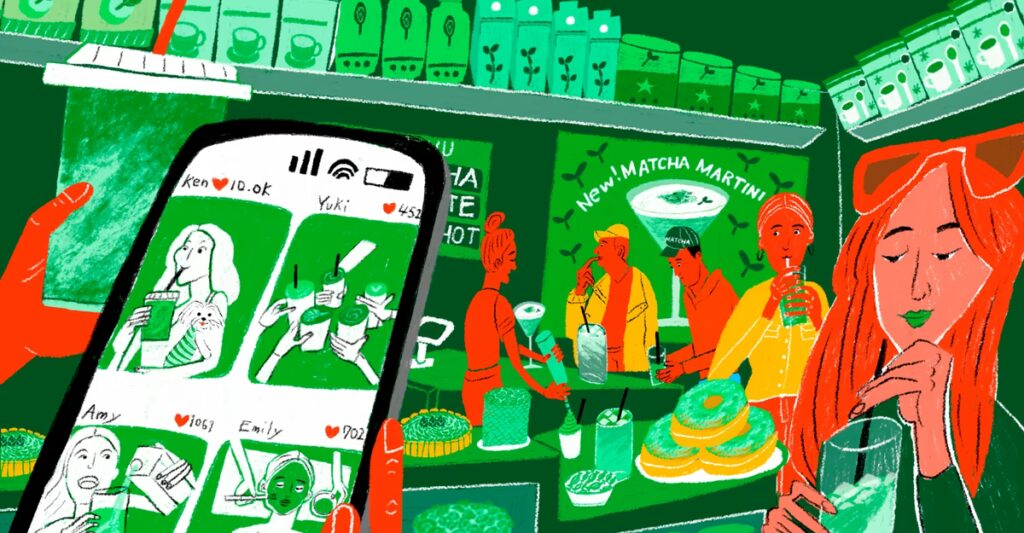A couple of years ago, Pokémon introduced a new monster: Poltchageist, a “Grass/Ghost type” with special abilities in “hospitality” and being “heatproof.” It is wily and homicidal; it is also matcha.
Sure—why not? Matcha, a special preparation of green tea, is already everywhere else. It’s in candy and restaurant desserts and ultra-firming eye cream and Frappuccinos and a pretty foul-sounding martini. Loacker, the 100-year-old Italian company that makes those Quadratini cookies, has introduced a matcha flavor. Dunkin’ sells a matcha doughnut. Thousands or possibly millions of young people on TikTok seem to have devoted their life to decanting green sludge from one vessel to another. Retail sales of matcha powder in the United States are up by 86 percent from three years ago. Matcha is outselling coffee at some cafés, including my local Blank Street, which isn’t really a coffeeshop at all anymore—earlier this year, the company drenched its interiors in celadon, dropped the word coffee from its name, and began offering an ever-expanding menu of matcha drinks in baroque, hybridized flavors, such as carrot cake and “daydream.”
In 2023, the global matcha market was estimated to be $4.3 billion. That number is expected to nearly double by the end of the decade. Like most trends, this one is a synthesis of several macro-level factors; among them: caffeine anxiety, the wellness boom, rising coffee prices, the proliferation of cheap home milk frothers, and the fact that the color green looks amazing on video. Matcha has appeared, as if out of nowhere, to brute-force its way into the mainstream American palate.
Except—matcha does not come from nowhere. It comes from Japan, where it has, for centuries, been used ceremonially, and where supply challenges are now colliding with world-historic demand. For hundreds of years, matcha has been a specialized product, one that is, by definition, laborious to produce: Camellia sinensis thrives in subtropical, rainy climates. The best, sweetest matcha—the matcha that people who know matcha drink—comes from plants grown in the shade, after which their two youngest leaves are picked (by hand, only at the very beginning of the season) and then steamed, de-stemmed, deveined, dried, and ground between granite. As an agricultural product, it is much more like wine than like, say, corn. But climate change is shrinking the land that C. sinensis can grow on, and the farmers who have traditionally cultivated it are getting older, and they lack willing successors for the demanding work.
[Read: The drink Americans can’t quit]
And so, as interest spikes, things are getting weird. From 2024 to 2025, the average price in Kyoto for first-flush tencha, the whole leaves used to make matcha, nearly tripled. Farmers outside Japan—in China and South Korea, for example—are frantically cultivating tencha, hoping to catch the wave. Manufacturers are taking advantage of the market’s lack of regulation and are selling ground-up green tea as matcha. Joseph Sorensen, the chair of UC Davis’s Department of East Asian Languages and Cultures and the acting director of the university’s Global Tea Institute, estimates that 90 percent of the powdered matcha on store shelves isn’t technically matcha at all. “Unauthorized resellers” are scalping marked-up matcha powder on social media as if it were Bad Bunny tickets. Counterfeiters are—allegedly!—selling colored powder and hoping no one notices. Kelly Shaw, who leads marketing for the U.K. matcha brand PerfectTed, told me that her company has seen others bulk ordering its matcha on Amazon and reselling it at competing local shops.
Like Poltchageist, PerfectTed is a product of its time. Quite literally: It became popular in 2023, after two of its co-founders, Marisa Poster and Teddie Levenfiche, went on Dragons’ Den, the United Kingdom’s version of Shark Tank, when they were both 25. There, they sold matcha using the language of utility and the logic of enterprise: Matcha, Poster told the cameras, evoked a venerable ritual, but more important, it was a “massive opportunity in the natural-energy-drink sector.” Poster had learned of matcha while trying to manage her ADHD and anxiety as an undergraduate at the University of Pennsylvania. She was using energy drinks and coffee to stay awake while studying but was constantly crashing. Matcha—which contains less caffeine than coffee does but more than other green tea does, as well as an amino acid said to aid focus—offered her a cleaner buzz.
All five Dragons fought to give Levenfiche and Poster their money. PerfectTed is now the U.K.’s fastest-growing retail brand across all sectors; according to Shaw, it alone imports 25 percent of Japan’s matcha supply. In addition to its flagship product, an energy drink, the company sells canned matcha lattes, Nespresso-compatible matcha pods, and powdered, sometimes flavored matcha. Its website features photographs of sporty people in green outfits and ad copy suggesting that matcha is not only better caffeine but more interesting caffeine: One graphic juxtaposes an intoxicatingly swirly jade-green matcha latte with a generic paper coffee cup, the latter stamped with BORING in red, like a voided check.
The traditional Japanese matcha ceremony involves patience, special equipment, and zero high-fructose corn syrup. Most of the new-wave matcha companies courting customers outside Japan are offering something else entirely, by admission and design. “I think if it remained in a tea ceremony and required a cha-wan and a whisk, it wouldn’t have become as popular as it has,” Shaw told me, gently, using the Japanese word for the special vessel in which matcha is traditionally brewed.
But even as these companies reject historical authenticity, they employ it as a selling point: PerfectTed, like many, many others, calls its powdered matcha “ceremonial grade,” a newly popular designation that is unregulated and completely meaningless. Matcha, in these companies’ tellings, presents an ancient and vaguely spiritual answer to the trials of modern life—an easy-to-consume, crash-free caffeine hit to get you through a looming deadline, a monk-approved solution to a problem that a monk would never have. Like miso, tahini, gochujang, and so many other global foods that have become trendy in this context-collapsed, free-associative, flavormaxxed culinary era, matcha is no longer really a fully formed cultural product with a heritage to be fidelitous to. Rather, it is a collection of appealing attributes, ready to be stripped for parts and endlessly remixed—a novel flavor, a functional ingredient, a component, a value proposition, a brand.
[Read: The golden age of the fried-chicken sandwich]
Matcha’s shift from niche commodity with sacred associations to international celebrity is not, in Sorensen’s view, wholly negative, as long as people don’t “pretend that they’re participating in Japanese culture by having a Starbucks latte.” The matcha ceremony’s practitioners take it seriously, and they’re watching it get more expensive—but, he told me, this is a “pretty specialized group of enthusiasts.” To the degree that the teenagers buying my local Blank Street out of carrot-cake matcha lattes are driving up the price of a pillar of Japanese life, we’re talking about something that’s closer to golf clubs than to communion wafers. And besides, Sorensen reminded me, much of the “matcha” flavor finding its way to the mass market isn’t actually matcha. “It’s pretty much the difference between something that is strawberry flavored,” he said, “and actual strawberries.” Food products can experience shortages, but flavors are a basically infinite resource, at least in food science’s modern era.
Sorensen and others are less worried about the rise in demand than they are about what comes after it. Matcha plants require three to five years to mature. Even if farmers were to have the arable land and the human labor to plant all the plants that the world wants right now, the world, at some point, is likely to stop wanting so much of it. Telegenic 20-somethings in the United States can get excited about a new way to stay focused or go viral, and almost immediately, a massive agri-industrial mechanism halfway around the world will shudder to life to satisfy them—a population that barely knows such a mechanism exists and that will probably move on soon anyway. Food, especially food that comes from plants, is slow. Trends, especially trends that come from the internet, are not.
The post What Comes After the Matcha Shortage? appeared first on The Atlantic.




